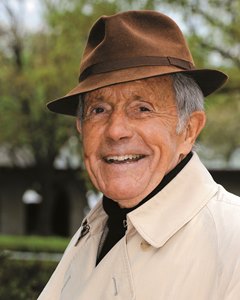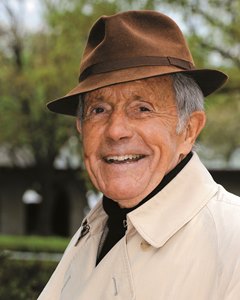Dozen to be Inducted Into Hall as Pillars of the Turf


The National Museum of Racing and Hall of Fame's Pillars of the Turf Committee has elected 12 members to the Hall of Fame.
The 2018 Pillars of the Turf inductees are: Elias J. "Lucky" Baldwin, August Belmont I, Cot Campbell, Penny Chenery, John W. Galbreath, Arthur B. Hancock Sr., Hal Price Headley, John Morrissey, Dr. Charles H. Strub, William Collins Whitney, Harry Payne Whitney, and Cornelius Vanderbilt Whitney.
The 12 Pillars join the previously announced selections of the racehorses Heavenly Prize and Preakness and trainer William Lakeland in the class of 2018. The Hall of Fame induction ceremony will take place Aug. 3 at 10:30 a.m. at the Fasig-Tipton sales pavilion. The event is open to the public and free to attend.
The museum's executive committee approved a measure in January allowing the Pillars of the Turf Committee to select as many as 12 inductees in both 2018 and 2019 to address the significant backlog of worthy candidates, as this Hall of Fame category was established only five years ago.
Baldwin (1828-1909), a native of Hamilton, Ohio, relocated to California during the Gold Rush and became successful in numerous business ventures. He owned several top Thoroughbreds and was one of the first prominent breeders in California. Racing under the name Santa Anita Stable, he campaigned champions Emperor of Norfolk (a Hall of Fame member) and Los Angeles, among others. Emperor of Norfolk won 21 of 29 starts, including the American Derby at Chicago's Washington Park in 1888, arguably the most prestigious race in the country at the time. Baldwin horses also won the American Derby in 1885 (Volante), 1886 (Silver Cloud) and 1894 (Rey el Santa Anita).
Belmont (1813-1890) who was born in Alzey, Germany, was introduced to Thoroughbred racing in 1866 by Leonard Jerome, who convinced him to be one of the incorporators of the American Jockey Club at Jerome Park, which Belmont helped finance. When Jerome Park opened that fall, Belmont became track president and won his first race as an owner with the filly Maid of Honor. In 1867, Belmont began his breeding operation by purchasing several broodmares and around 1,000 acres on Long Island, N.Y., for his Nursery Stud. In 1870, Belmont was one of six founders of Long Branch Racetrack in New Jersey, which was later renamed Monmouth Park.
Campbell, born on Sept. 27, 1927, in New Orleans, began syndicating racehorses in 1969 and created Dogwood Stable as a partnership venture shortly after. Based in Aiken, S.C., Dogwood partnerships produced more than 80 stakes winners, including 1990 Preakness Stakes (G1) winner Summer Squall. Summer Squall went on to sire dual classic winner Charismatic and the Dogwood-owned Breeders' Cup Juvenile Fillies (G1) winner Storm Song. Palace Malice delivered a second victory in the Triple Crown series for Dogwood when he won the 2013 Belmont Stakes (G1). Campbell's partnership concept paved the way for numerous other groups that followed, providing a successful model and making Thoroughbred ownership more attainable and inclusive.
Chenery (1922-2017), a native of New Rochelle, N.Y., was a daughter of Christopher T. Chenery, founder of the famed Meadow Stud in Virginia. She successfully guided the family's ancestral farm and racing stable through a period of uncertainty and led it to the highest ranks in the sport and business of Thoroughbred racing, most notably campaigning champion Riva Ridge and 1973 Triple Crown winner Secretariat. Chenery became a respected leader in the sport, serving as president of the Thoroughbred Owners and Breeders Association from 1976 through 1984. She was also president of the Grayson Foundation and was welcomed into The Jockey Club in 1983.
Galbreath (1897-1988) was born in Derby, Ohio, and attended Ohio University before serving in World War I. After the war, he returned to school, finished his degree, and began a career in commercial property development. Galbreath's business interests steadily expanded, including ownership of baseball's Pittsburgh Pirates from 1945-1985. Galbreath became a key figure in New York racing in the early 1950s, overseeing the construction of the new Aqueduct Racetrack, and he was later involved in the extensive rebuilding of Belmont Park. He began acquiring property in Kentucky in the mid-1940s, and in 1949 he bought the 650-acre core of Col. E. R. Bradley's Idle Hour Farm and renamed it Darby Dan. The farm stood notable stallions such as Swaps, Ribot, Sword Dancer, Sea-Bird II, Graustark and His Majesty, among others. Darby Dan eventually produced champions Chateaugay, Primonetta, Little Current, Tempest Queen and Sunshine Forever, as well as Roberto, a champion in both Ireland and England and winner of the Epsom Derby.
Hancock (1875-1957) established Claiborne Farm in Paris, Ky., and developed it into an international leader in racing, breeding and sales. Hancock was born in Ellerslie, Va., where his father, Richard Johnson Hancock, owned Ellerslie Stud. In 1908, Arthur Hancock married Nancy Tucker Clay of Paris, Ky., who inherited a family farm they named Claiborne. Hancock expanded his father's Ellerslie Stud to his wife's Kentucky property and eventually transferred the bulk of his operation there. Hancock began importing significant breeding stock from Europe to the benefit of Claiborne, including four-time leading sire Sir Gallahad III, who sired 1930 Triple Crown winner Gallant Fox. Overall, Hancock bred 138 stakes winners, including 10 champions. He was America's leading breeder in wins eight times and in earnings five times.
Headley (1888-1962), a native of Lexington, returned to his home state in 1908 from Princeton University to take over management of his family's farms, Beaumont and La Belle. In 1912, Headley began to actively purchase horses for his own stable, and throughout the next half-century he became one of the foremost breeders in America. Headley bred the champions Alcibiades, Apogee, Menow and Askmenow among a total of 88 stakes winners between 1916 and 1953. Headley was one of the original organizers of Keeneland. Thoroughbred racing in Lexington had suffered a hiatus of nearly a decade after the Kentucky Association track was shut down in 1927, ending more than a century of activity. Keeneland opened in the fall of 1936 with Headley serving as its first president, a post he held until 1951.
Morrissey (1831-1878) was born in Ireland and grew up in Troy, N.Y. He used sheer will and powerful fists to become an against-all-odds American success story and the originator of Thoroughbred racing at Saratoga Race Course. An undefeated bare-knuckle boxing champion, Congressman and New York State Senator, Morrissey amassed a considerable fortune through ownership in various gambling houses in New York City and Saratoga. In 1863, Morrissey orchestrated Saratoga's first formal Thoroughbred race meeting at an old trotting course. The inaugural four-day meeting was described in The Spirit of the Times as a great success, laying "the foundation for a great fashionable race meeting at the Springs, like that at Ascot in England." Morrissey built upon the foundation meeting by enlisting several prominent sportsmen to back his opening of Saratoga Race Course the following year. As Saratoga's impresario, Morrissey led the track's day-to-day operations and maintained an ownership interest until his death in 1878.
Strub (1884-1958), a native of Hollister, Calif., was a prominent dentist who became involved in Thoroughbred racing in 1933 when he was granted a license to build and operate a track in San Francisco under the management name of the St. Francis Jockey Club. The project, however, was abandoned, and Strub instead partnered with filmmaker Hal Roach in developing the Los Angeles Turf Club and Santa Anita Park, which opened Christmas Day 1934. It was there that the first of the famed "Hundred Granders," the Santa Anita Handicap, was inaugurated. The race became known as the "Big Cap" and brought credibility and significant attention to racing in the Los Angeles area, which had been dormant for a quarter-century. Many of the top stables in the sport gravitated to Santa Anita under Strub's leadership.
William Collins Whitney (1841-1904) was a native of Conway, Mass. He graduated from Yale University and attended Harvard Law School before becoming involved in politics, including a stint as Secretary of the Navy under President Grover Cleveland. In 1896, after scaling back his political interests, Whitney was introduced to Thoroughbred racing by August Belmont II and John E. Madden. Whitney spearheaded the restoration of top-class racing at Saratoga after it had become diminished under previous leadership in the 1890s. Leading a syndicate of prominent owners, Whitney spent a half-million dollars to improve the track to return Saratoga to its former glory. He also promoted the transition of the key New York yearling sale to Saratoga from downstate and was involved in the creation of Belmont Park. Although his association with racing lasted less than a decade, Whitney bred 26 stakes winners and developed a broodmare band that impacted the sport for generations. His son, Harry Payne Whitney, purchased several of the top offerings and built upon his father's legacy.
Harry Payne Whitney (1872-1930) was born in New York City and graduated from Yale. A world-class polo player, Whitney bought his first interest in a racehorse in 1902. He raced in partnership with Herman B. Duryea until purchasing much of the bloodstock of his late father at a dispersal sale in 1904. Those acquisitions, including the stallion Hamburg and several notable broodmares, served as the foundation for the most successful racing and breeding operation in America for more than a quarter-century. Whitney bred 192 stakes winners, including 20 champions. The 20 champions bred by Whitney include Hall of Fame members Regret, the first filly to win the Kentucky Derby. Upon his death in 1930, Whitney's Kentucky farm and bloodstock passed to his son, Cornelius Vanderbilt Whitney, who continued to build upon the family's influential legacy within the sport.
Cornelius Vanderbilt "Sonny" Whitney (1899-1992) was born in Roslyn, N.Y., and graduated from Yale. He served in the Army as a second lieutenant and flight instructor during World War I and was awarded the Distinguished Service Medal and Legion of Merit and later served under President Harry S. Truman as assistant secretary of the Air Force and undersecretary of commerce. Whitney followed the success of his father in both polo and Thoroughbred racing. Whitney acquired his father's breeding stock and racing stable in 1930 and enjoyed immediate success with greats such as Equipoise and Top Flight. Whitney won the Belmont Stakes in 1947 with Phalanx and again in 1951 with Horse of the Year Counterpoint. Whitney was one of the founders of the National Museum of Racing in 1950 and served as its first president. He also spent time as a director at Churchill Downs.
The Museum's Pillars of the Turf Committee is comprised of D. G. Van Clief (chairman), Edward L. Bowen, Bob Curran, Jane Goldstein, Ken Grayson, Jay Hovdey, G. Watts Humphrey, Bill Marshall, Daisy Phipps Pulito, Barry Schwartz, Mary Simon, Stella Thayer and Gary West.
